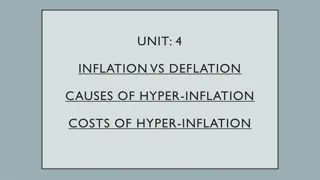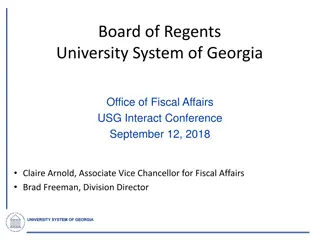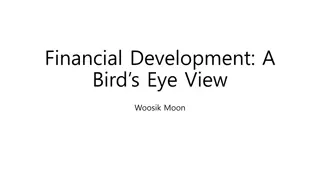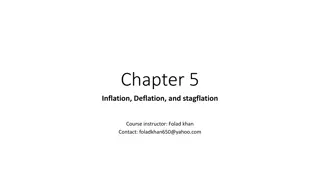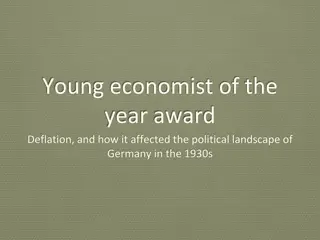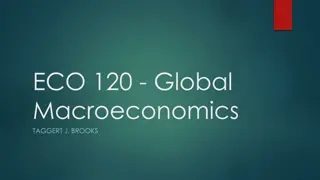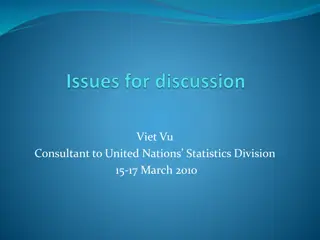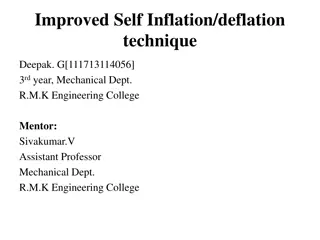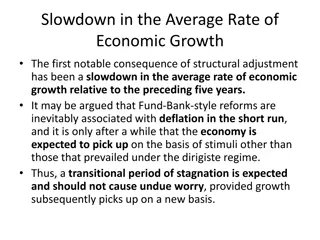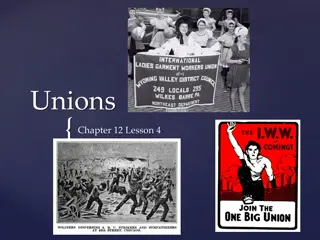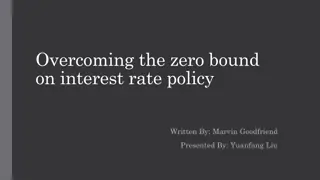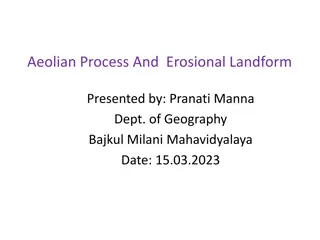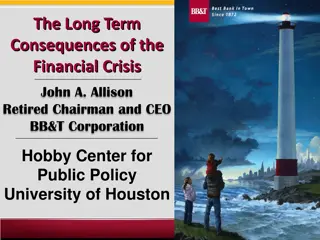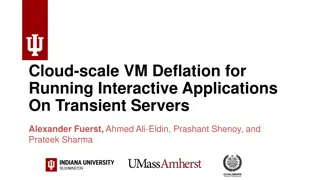Inflation vs. Deflation and Hyperinflation Causes and Costs
The content explores the key differences between inflation and deflation, highlighting how inflation benefits producers while deflation helps consumers. It delves into the causes of hyperinflation, such as an increase in the money supply and demand-pull inflation, and explains the detrimental effect
0 views • 7 slides
Inflation vs. Deflation: Causes and Impacts of Hyperinflation
Inflation and deflation are two economic phenomena with significant impacts on the economy. Inflation, characterized by rising prices, benefits producers while deflation, marked by falling prices, benefits consumers. Hyperinflation, when prices skyrocket, is caused by increased money supply and dema
0 views • 7 slides
GASB Statement 83: Asset Retirement Obligations
GASB Statement 83 standardizes the recognition and measurement requirements for asset retirement obligations (ARO) to enhance financial reporting consistency. Governments must recognize AROs when liabilities are incurred and reasonably estimable, based on external and internal obligating events. Mea
0 views • 30 slides
Economic and Monetary Policies in Korea and Worldwide
This course provides an insightful exploration of major policy issues related to money, banking, and financial development globally and in Korea. It covers the goals and conduct of economic and monetary policies, the impact of money on economies, financial stability, and responses to depression and
2 views • 25 slides
Inflation, Deflation, and Stagflation in Economics
Inflation is the continuous increase in the general price level, leading to a loss of the money's value. This chapter explores the causes of inflation, including demand-pull and cost-push factors. Remedies such as monetary and fiscal policies are discussed to control inflation. Additionally, the con
0 views • 14 slides
Deflation Worries in the Eurozone and Fisher's Debt Deflation Theory
Recent concerns about deflation in the eurozone have led to discussions about the potential impacts on the economy. This article explores the Eurostat index data showing a significant drop in inflation levels across several European countries. It also delves into Irving Fisher's Debt Deflation theor
0 views • 34 slides
Economic Crisis and Political Turmoil in 1930s Germany
Deflation and the Great Depression had a profound impact on Germany in the 1930s, leading to widespread unemployment, economic turmoil, and political unrest. The Weimar Republic faced severe challenges as the Nazi party gained power amidst the economic crisis, exacerbated by the aftermath of World W
0 views • 16 slides
Inflation and Its Economic Implications
This content covers topics such as inflation, deflation, winners and losers from inflation, shoe-leather costs, and the natural rate of unemployment. It explains how inflation impacts the real wage, real income, and overall economic stability. Additionally, it discusses the challenges of disinflatio
0 views • 8 slides
Institutional Arrangement for GRP Compilation: Challenges and Solutions
The content discusses the institutional arrangement for compiling Gross Regional Products (GRPs) by either regional statistical offices or National Statistical Offices (NSO). It highlights the pros and cons of both approaches, focusing on factors like regional demand, fiscal constraints, data accura
0 views • 5 slides
Enhanced Self-Inflation/Deflation Technique for Improved Tire Performance
Improved self-inflation/deflation technique developed by Deepak G at R.M.K. Engineering College offers quick inflation and deflation, enhancing safety, fuel efficiency, and reducing pollution. The innovation aims to address under-inflation issues leading to accidents, injuries, and deaths, as well a
0 views • 19 slides
Consequences of Structural Adjustment and Economic Slowdown
Structural adjustment programs have led to a slowdown in the average rate of economic growth, transitioning through phases of deflation and recovery. This has impacted industrial performance, agricultural sector growth, and rural employment. The reforms have resulted in a shift towards stabilization
0 views • 15 slides
The Rise of Unions and Labor Conditions in the Late 19th Century
Labor conditions in the late 1800s were harsh, with long work weeks, low wages, and no benefits for workers. Deflation caused a rise in the value of money, leading to resentment among workers who organized into unions to demand better wages and working conditions. Craft workers and common laborers f
0 views • 17 slides
Overcoming the Zero Bound on Interest Rate Policy by Marvin Goodfriend
Exploring the zero bound problem in interest rates, the paper discusses the challenges of negative nominal interest rates, their impact on the economy's stability, and proposed solutions such as carry taxes on money, open market operations, and monetary transfers. Factors affecting real interest rat
0 views • 33 slides
Aeolian Processes and Erosional Landforms
Aeolian processes, driven by wind, shape landscapes through erosion and deposition. This presentation by Pranati Manna explores wind erosion methods like deflation, corrasion, and attrition, as well as transportation and deposition mechanisms. Aeolian landforms, including deflation basins, mushroom
0 views • 19 slides
Long-Term Consequences of the Financial Crisis: A Critical Analysis
Government policies, primarily from the Federal Reserve, triggered the financial crisis by fueling overinvestment in residential real estate. This resulted in a burst bubble, deflation, and liquidity issues, leading to a significant recession. The crisis exposed the deeper philosophical flaws in eco
0 views • 18 slides
Progress of Abenomics in the Japanese Economy
Abenomics, initiated by Prime Minister Shinzo Abe, aims to revitalize the Japanese economy through a three-pillared strategy focusing on economic growth, structural reform, and price stability. Challenges such as deflation and a large national debt are being addressed through measures like doubling
0 views • 17 slides
Impact of Banking Crises on the Real Economy: Lessons from History
Understanding the influence of banking crises on the real economy, particularly during the Great Depression, where massive bank suspensions triggered economic turmoil. The interplay between banking panics, monetary deflation, bank failures, loss of credit information, and debt deflation worsened the
0 views • 55 slides
Cloud-Scale VM Deflation for Running Interactive Applications on Transient Servers
This research explores the concept of deflatable virtual machines to run interactive applications on transient cloud servers without facing unexpected preemption. By reclaiming resources from low-priority VMs and allowing forward progress with some performance degradation, the method aims to provide
0 views • 29 slides
Aeolian Processes and Landforms
Aeolian processes are crucial in arid and semi-arid regions, involving erosion, transportation, and deposition by wind. Factors like wind velocity, grain size, rock composition, and vegetation influence erosion. Different types of wind erosion include deflation, abrasion, and attrition. The transpor
0 views • 18 slides
